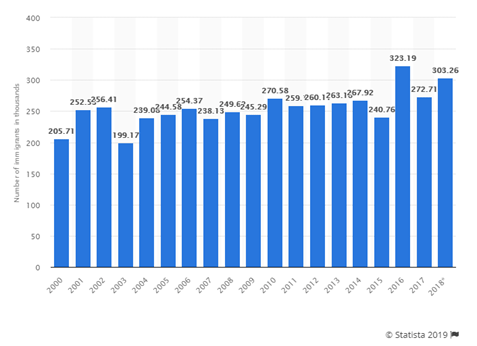May 2nd, 2019 | Sterling
The Globalization of the workforce and other trends in the Canadian hiring market
With the demand for skilled talent on the rise, how does an organization adjust to the latest trends?
With the unemployment rate in Canada continuing to be the lowest in decades, workers have become more and more confident in their job search, forcing organizations to re-evaluate their hiring strategy.
But before jumping to what it means for the organizations, let’s examine the current employment landscape in Canada.
Innovation – As the economy grows, Canada is struggling to keep up with the changing market. Innovation is key to a prosperous economy. Lack of innovation is a serious impediment to the growth of Canadian labor efficiency and productivity. According to CPHR[1], Canada’s performance in this area has been described as dismal based on deteriorating domestic trends as well as international perspective.
Gig economy – Whether we like it or not, the gig economy has provided an incredible opportunity for people to set their own work schedule catered to the lifestyle that they chose.From rides and food delivery to graphic designers and many other freelance services, the gig economy continues to grow. In the study conducted in the US, LinkedIn[2] predicts that by 2020, 43% of the workforce will be made up of freelancers. Many new gig-economy businesses are born out of an industry transformation, pushing the boundaries of the legislation. Contractors are the new norm blurring the relationship between individuals and the organizations through which they work.
Immigration – International Immigration to Canada reached record levels in 2018. Canada’s population grew by 168K in the 2nd quarter of 2018, of which 82% or 139K was attributed to international migration. Statistics Canada said international migratory increase was the main driver of population growth in most Canadian provinces and the Yukon Territory between April 1 and July 1. The workforce gains are even more impressive when looked at regionally. In 2016, immigrants represented half of all workers in the Toronto, Ontario, metropolitan region. Vancouver, British Columbia, had the second-highest proportion of immigrants in its labor force at 43.2 per cent, followed by Calgary, Alberta, at 32.5 per cent.

So, what do these 3 trends have in common?
- This is an employee’s market and the hiring experience is key to making the right first impression. The hiring process and a smooth onboarding experience ensures the success of the new hire in the organization.
- Global expansion is a big part of innovation. As organizations expand globally, many HR professionals are now faced with finding talent outside of Canada.
- New hires entering the job market now have employment history that expands beyond Canada.
Whether your organization is expanding globally or simply hiring those with employment experience outside of Canada, the need to conduct background screening is more important than ever. And with laws and regulations that differ from country to country, this is no easy task.
Local considerations
- The local framework through which background screening information is provided can be very unique to a country. In Germany, for example, employment verification is conducted through reference letters. In the Netherlands, criminal “VOG” search requires a detailed description of the role. Dutch authorities then make the decision whether any convictions should be reported based on the role.
- GDPR in Europe has increased awareness and concern around how personal information is handled, both in terms of individuals’ expectations, and organizations’ willingness to disclose personal information. This has forced companies worldwide to rethink their policies and processes and change the way they talk about privacy.
- Legislation is also beginning to be adopted where the results of a criminal check are sent to the candidate for them to provide to the employer. It is a current practice in the UK with the Basic Disclosure, when run through DBS. A similar approach was adopted in Canada, when Ontario introduced Bill 113, which recognizes the self-disclosure model used by background screening providers as sufficient to meet the requirement.
Recommendations
As your organization re-evaluates new hiring strategies and adjusts to the new trends, it is important to remember that there is not a one-size-fits-all market. Your hiring practices should be based on the following:
- Geographic – local social norms are important to consider, while alternatives are not always available – be considerate to the population you are hiring.
- Role-Based – Since each situation is unique, you need to work with your background screening provider to create an appropriate program. For example, a paper process maybe preferred by mining companies hiring in geographically remote regions with inconsistent internet connection and a population who typically does not have computers at home. Your background services provider should be able to accommodate any challenges while maintaining a high level of usability.
- Risk Tolerance – Ensure your provider can automate any uniqueness to your program and allow for immediate change, at your pace.
[1] https://cphr.ca/blog/2017/03/29/canada-needs-aggressive-innovation-technology-development-to-compete/
[2] https://blog.linkedin.com/2017/february/21/how-the-freelance-generation-is-redefining-professional-norms-linkedin
This publication is for informational purposes only and nothing contained in it should be construed as legal advice. We expressly disclaim any warranty or responsibility for damages arising out this information. We encourage you to consult with legal counsel regarding your specific needs. We do not undertake any duty to update previously posted materials.


